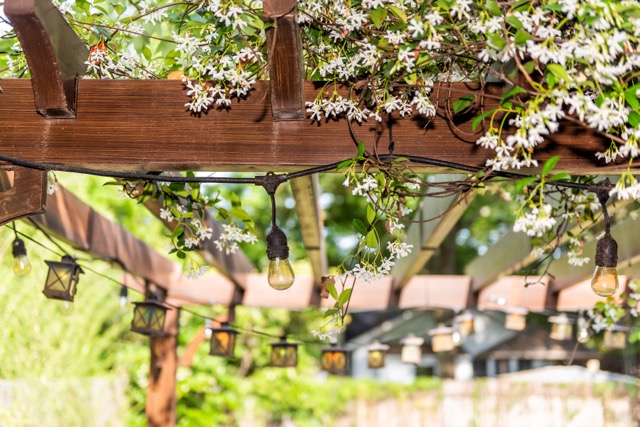The pergola is a popular yard design element but what, exactly, does it do?
If you want to create a focal point in your landscaping, you have a lot of options. From water features to outdoor dining spaces, Cottonwood Landscapes can help with it all. Today we’ll share some of the reasons why pergolas are so popular.
The Best of Both Worlds
Pergola means “projective eave,” and it offers the best of both worlds- sunlight and shade.
When you think of providing shade in your yard, you might picture trees, shade sails, and canopies, or a roof for a seating area. But what if, instead, you chose an open-air structure like a pergola? You might wonder how something constructed of open slats overhead could effectively block the sun; won’t the light constantly stream straight through the pergola into your face and onto your outdoor furniture? While it’s true pergolas allow light and air through, you can control how much.
There are some basic types of pergolas used in landscaping:
- Gable
- Sail
- Skillion
- Open-Top
We go a bit more into the details of these pergolas on our website, HERE. Regardless of which architectural style you choose, there are ways to enhance the function of your pergola.
Blending Form and Function
Truthfully, we love a pergola for its seamless blend of beauty and functionality. You can still have a light, airy space without compromising the overall aesthetic of your yard design. Although pergolas are often structures with open slats serving as a “roof,” they can be customized to provide varying levels of shade throughout the day.
Live Vegetation
Often, a pergola itself is not meant to offer the maximum amount of shade. Instead, it serves as a trainer for creeping plants that fill in the gaps. Over time, foliage can grow up the posts and along the roof slats to block sunlight and create a green retreat. It’s much like sitting under a leafy tree, but you don’t have to worry about roots growing too close to the foundation of your home, or disrupting concrete slabs and sidewalks in your yard.
Traditionally, pergolas have been used to grow grapes because they thrive when elevated and, in turn, they can provide shade to homeowners or vintners.
Plants for Your Pergola
- Black-Eyed Susan Vine
- Clematis
- Climbing Rose
- Honeysuckle
- Morning glory
- Trumpet Vinereprieve
If you have questions about what plants might work best in your pergola, let us know!
Dried Grass or Leaves
The look and the function you’re dreaming of might be best achieved with artificial or real dried grasses, bamboo, or leaves. Sheaths of dried vegetation can be affixed to your pergola’s roof to help with sun control and can lend a casual aesthetic to your yard design. As with other options, you can control the amount of light that gets through, keeping the look of a classic, open-air pergola or buttoning things up a little tighter.
Fabric
If you like the thought of adding something to your pergola to offer shade but don’t want to deal with pests buzzing around due to vegetation, fabric might be your answer. An awning, sail, or curtains can customize the amount of sunlight that streams through a pergola.
Whether you weave strips of fabric through the pergola roof slats, drape a sail over the top, or attach curtains around the sides, you can give the appearance of an outdoor room. Fabric coverings not only provide a reprieve from the sun, but they can help block wind and rain on an otherwise lovely day.
If you want to get even more sophisticated, you could have a retractable canopy installed on your pergola. Like a sunroof in your vehicle, it can be fully or partially opened at your convenience.
When shopping for fabric options, look into which types offer UV protection that can complement your SPF.
Spacing and Angles
Even if you don’t use your pergola as a trellis to train vegetation or affix shade sails, you can still optimize the shade it provides. The placing of your roof slats or lattice panels overhead can increase how much shade your pergola offers throughout the day. Installing roof slats closer together will minimize how much light gets through.
Another consideration is the tangle at which each roof slat is installed. Obviously, slanted slats offer more surface area to block sunlight, whereas slats that are installed upright allow more light through. Where your pergola is installed will also affect the amount of light that gets through at varying times of day, so talk it over with a landscape designer for best results.
Now that you know the point of a pergola, consider looking into having one custom-built for your space by Cottonwood Landscapes. You can learn more about our pergola options on our website, or feel free to give us a call.

